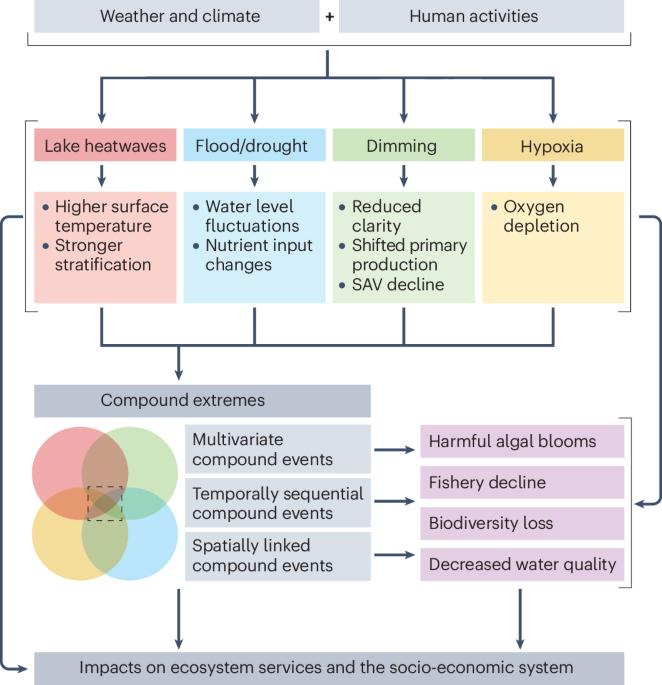Extreme and compound events in lakes
引用次数: 0
Abstract
Extreme and compound events disrupt lake ecosystems worldwide, with their frequency, intensity and duration increasing in response to climate change. In this Review we outline evidence of the occurrence, drivers and impact of extreme and compound events in lakes. Univariate extremes, which include lake heatwaves, droughts and floods, underwater dimming episodes and hypoxia, can occur concurrently, sequentially or simultaneously at different locations to form multivariate, temporal or spatial compound events, respectively. The probability of extreme and compound events is increasing owing to climate warming, declining lake water levels in half of lakes globally, and basin-scale anthropogenic stressors, such as nutrient pollution. Most in-lake extreme events are inherently compound in nature owing to tightly coupled physical, chemical and biological underlying processes. The cascading effects of compound events propagate or dissipate through lakes. For example, a heatwave might trigger stratification and oxygen depletion, subsequently leading to fish mortality or the proliferation of harmful algal blooms. Interactions between extremes are increasingly observed and can trigger feedback loops that exacerbate harmful algal blooms and fishery declines, leading to severe ecological and socio-economic consequences. Managing the increasing risk of compound events requires integrated models, coordinated monitoring and proactive adaptation strategies tailored to the vulnerabilities of lake ecosystems. Extreme and compound events in lakes are increasing in severity and frequency in response to climate change and basin-scale anthropogenic stressors. This Review explores the occurrence, drivers and impact of such events, focusing on their physical and ecological drivers, impacts and management responses.

湖泊中的极端和复合事件
极端和复合事件破坏了全球的湖泊生态系统,其频率、强度和持续时间随着气候变化而增加。在这篇综述中,我们概述了湖泊极端和复合事件的发生、驱动因素和影响的证据。单变量极端事件,包括湖泊热浪、干旱和洪水、水下变暗事件和缺氧,可以同时、顺序或同时在不同地点发生,分别形成多变量、时间或空间的复合事件。由于气候变暖、全球一半湖泊的湖泊水位下降以及流域尺度的人为压力因素(如营养物污染),极端和复合事件的概率正在增加。由于物理、化学和生物的基本过程紧密耦合,湖内极端事件本质上是复合的。复合事件的级联效应通过湖泊传播或消散。例如,热浪可能引发分层和氧气消耗,随后导致鱼类死亡或有害藻类大量繁殖。越来越多地观察到极端之间的相互作用,并可能引发反馈循环,加剧有害藻华和渔业衰退,导致严重的生态和社会经济后果。管理日益增加的复合事件风险需要综合模型、协调监测和针对湖泊生态系统脆弱性的主动适应战略。由于气候变化和盆地尺度的人为压力源,湖泊极端和复合事件的严重程度和频率正在增加。本文探讨了这些事件的发生、驱动因素和影响,重点是它们的物理和生态驱动因素、影响和管理对策。
本文章由计算机程序翻译,如有差异,请以英文原文为准。
求助全文
约1分钟内获得全文
求助全文

 求助内容:
求助内容: 应助结果提醒方式:
应助结果提醒方式:


